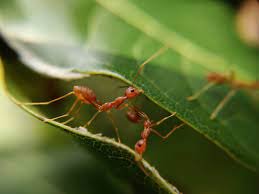Ants have an extraordinary ability to infiltrate homes, no matter how high or secure they seem. Their colonies consist of thousands of relentless workers, always in search of food and shelter. These tiny creatures navigate complex environments with ease, using their powerful sense of smell and teamwork to locate resources. Once a single scout ant finds food, it lays a pheromone trail, leading an entire army to the source.
Even tall buildings are not safe from their invasion. Ants exploit cracks, pipes, and even electrical wiring to move between floors. They establish networks that stretch across entire structures, creating hidden pathways that allow them to access kitchens, bathrooms, and other areas where moisture and food are readily available. Their ability to adapt to urban environments makes them one of the most persistent household pests.
Ants thrive in diverse conditions and exist in an estimated 22,000 species worldwide. Scientists consider tropical Australia a global hotspot for ant diversity, with around 5,000 species in its tropical regions alone. These insects play a crucial role in ecosystems by aerating soil, controlling pests, and recycling organic material. However, when they invade homes, they become a nuisance, contaminating food and creating unsightly trails across walls and countertops.
Their survival strategies rely on efficient communication and division of labor. Worker ants forage tirelessly, while the queen remains in the nest, ensuring the colony’s growth. Some species form supercolonies that span vast distances, allowing them to dominate entire neighborhoods. Their small size and adaptability make it nearly impossible to block all entry points, leading to frequent household infestations.
Weather changes often drive ants indoors. During dry spells, they seek water sources inside homes, while heavy rains force them to relocate to drier areas. Seasonal shifts influence their movement patterns, making infestations more common during extreme weather conditions. Homeowners may notice an increase in ant activity during summer or monsoon seasons.
Preventing ant infestations requires sealing entry points, maintaining cleanliness, and removing food sources. Natural deterrents like vinegar and citrus peels can disrupt their trails, but complete eradication often requires professional pest control. As long as food and shelter are available, ants will continue to find their way into even the most secure homes.
Ants are among the most resourceful creatures, capable of reaching almost any space, including high-rise apartments. Their small size allows them to slip through the tiniest cracks in walls, doors, and windows. Even well-sealed buildings are not immune, as ants use plumbing systems, ventilation ducts, and electrical wiring to travel between floors. Once inside, they establish hidden nests in wall voids, under floors, and behind kitchen cabinets, making them difficult to eliminate.
Their ability to locate food with remarkable precision plays a key role in their rapid spread. Even a few crumbs or a small spill can attract an entire colony. Ants rely on pheromone trails to guide others to food sources, creating well-organized highways that appear almost overnight. Their collective intelligence ensures that once they find an accessible spot, they return to it repeatedly, making infestations persistent.
Certain species have developed behaviors that make them even more difficult to control. Some ants form multiple satellite nests, meaning that even if one nest is destroyed, others continue to thrive. Others can live both indoors and outdoors, seamlessly shifting between different environments based on weather conditions. These adaptive strategies allow them to survive in the most challenging urban landscapes.
Temperature and humidity also influence their movement. Warmer temperatures encourage ants to forage more aggressively, while excessive rainfall may drive them indoors to escape flooding. Many homeowners notice a sudden increase in ant activity during seasonal changes, as colonies adjust to new environmental conditions. Even in winter, some species remain active inside heated buildings, sustaining themselves on available food sources.
Cleaning alone is often not enough to prevent ants from invading. While keeping food sealed and surfaces clean can help reduce their attraction, sealing off entry points and using targeted pest control methods are often necessary for complete removal. Some homeowners turn to natural repellents like cinnamon, coffee grounds, and essential oils, which can disrupt their trails temporarily. However, professional treatments are sometimes the only way to break their stronghold and prevent recurring infestations.
Ants have mastered the art of survival, making them one of the most persistent and resilient invaders in both homes and towering skyscrapers.

